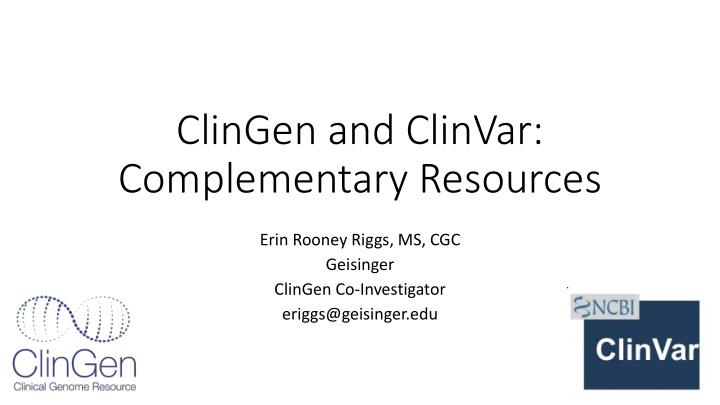



ClinGen and ClinVar: Complementary Resources Erin Rooney Riggs, MS, CGC Geisinger ClinGen Co-Investigator eriggs@geisinger.edu
ClinGen and ClinVar: What’s the Difference? • ClinGen and ClinVar work together to provide complementary resources to support genomic interpretation • ClinVar is a DATABASE funded by intramural NIH funding and maintained by the NCBI • Goal: Public archive of [ any ] reports of the relationships between [ any ] variants and [ any ] conditions • ClinGen is a PROGRAM funded by NHGRI • Goal: Identifying clinically relevant genes and variants for use in precision medicine and research
What i is ClinVar? • Public archive of variant-phenotype assertions, submitted from a variety of sources, including: • Clinical laboratories • Research projects • Expert panels • Other databases, etc. • Different from dbSNP, dbVar, which primarily maintain information about locations, types of variants
What d does ClinVar DO? DO? • Facilitates the evaluation of variant-phenotype assertions by: • Archiving submitted interpretations of gene-disease relationships • Aggregating data from multiple submitters • Determine if there is a consensus about the interpretation • ClinVar DOES NOT interpret variants!
What’s curr rrently i in ClinVar?
ClinVar is a a submitter-drive ven resource • There are many pieces of information that ClinVar CAN collect on a variant, but if a submitter does not submit them , they aren’t available. • Quality of submissions vary • When assessing the information you find in ClinVar, you must assess the quality of the submitter/submission itself
Assessing Quality in ClinVar • IN GENERAL, one mark of a submission’s quality is it’s review level – at minimum, you should be able to figure out the methods by which the variant was evaluated • These are known as “assertion criteria” • When a submitter provides assertion criteria, the submission receives at least 1 star
https://www.clinicalgenome.org/lablist/
https://www.clinicalgenome.org/lablist/
What is the Clinical Genome Resource (ClinGen)?
ClinGen’s Curation Efforts
Which variants in a gene a actually cause disease? • Several different efforts going on in this space • Addressing existing classification disagreements: Inter-laboratory discrepancy resolution • Sequence and copy number variants • Preventing future classification disagreements: Modifications of the current ACMG/AMP sequence variant guidelines (Sequence Variant Interpretation WG) • General/quantitative specifications of current guidelines • Disease-specific modifications
Discrepancy Resolution Efforts Resolved 87.2% of discordant Updated classifications for 63.8% of sequence variant classifications CNVs evaluated overlapping dosage between participating labs sensitive genes
ACMG/AMP Guidelines ClinGen Expert Panels Cardiovascular Neurodevelopmental Disorders Sequence Variant Interpretation WG Hereditary Cancer Harmonize recommendations for Metabolism modifying ACMG guidelines RASopathies, etc. Gene/Disease Specific General recommendations to ACMG Guidelines ACMG Guidelines Slide courtesy of Steven Harrison, PhD
ClinGen’s Curation Efforts
Does this gene, when significantly altered, cause this disease? • Defines the criteria needed to assess (genetic evidence, gene-level experimental evidence) • Describes the strength evidence supporting a gene-disease relationship in a semi-quantitative manner • Allows users to methodically classify the validity of a given gene- disease pair
Role has been repeatedly demonstrated in research & clinical diagnostic settings Definitive • Upheld over time (in general, at least 3 years) • No convincing contradictory evidence ≥2 independent studies with: • Multiple pathogenic variants in unrelated probands Strong • AND • Several different types of supporting experimental data • OR • Excess of pathogenic variants in cases vs. controls • No convincing contradictory evidence Several unrelated probands with pathogenic variants • Some supporting Moderate experimental data • No convincing contradictory evidence <3 unrelated probands with pathogenic variants • OR • Multiple variants reported Limited in unrelated probands but without sufficient evidence for pathogenicity • No convincing contradictory evidence No evidence reported for a causal role in disease (candidate genes, etc.), No Evidence Reported therefore no pathogenic variants have been identified in humans to date. Convincing evidence disputing a role for this gene in this disease has arisen • Conflicting Disputed Disputing evidence need not outweigh existing evidence supporting the Evidence Reported gene:disease association Evidence refuting the role of the gene in the specified disease has been Refuted reported and significantly outweighs any evidence supporting the role • Applied at the discretion of clinical domain experts after thorough review of available evidence
Using Gene-Disease Validity in Clinical Practice • Laboratory: test design • Clinician: Test ordering – which panel to choose? • May consider ordering only panels with established genes • Bigger is not always better! • Clinician: Result interpretation – dealing with results in genes of uncertain significance
ClinGen’s Curation Efforts
Is a gen ene or or g gen enomic r ic reg egio ion d dos osage s sen ensitiv itive? • Originally created in 2011 as a resource to assist in the interpretation of copy number variants (ISCA, ICCG, ClinGen) • Evidence-based process to assess genes and regions for dosage sensitivity • Haploinsufficiency • Triplosensitivity • Goal: to create a genome-wide dosage sensitivity map
Riggs et al. Clin Genet 2012
Using Dosage Sensitivity in Clinical Practice • Interpreting copy number variants • Which genes in the deleted/duplicated region are dosage sensitive? • Beyond copy number variants… • Which diseases are potentially caused by LOF mechanism?
ClinGen’s Curation Efforts
Which genes, when significantly altered, confer a high risk of serious disease that could be prevented or mitigated if the risk were known?
Hunter et al. Genet Med 2016
Using Clinical Actionability in Clinical Practice • May help guide return of secondary or incidental findings • Actionability reports provide a comprehensive overview of clinical features, natural history, and management recommendations based on published guidelines
Acknowledgements • ClinGen PIs and working group members • >570 individuals from >230 institutions worldwide • Funding: NIH/NHGRI U41HG006834, U41HG009649, U41HG009650 • ClinVar staff • Team lead: Melissa Landrum • Questions? • eriggs@geisinger.edu • clingen@clinicalgenome.org
Recommend
More recommend